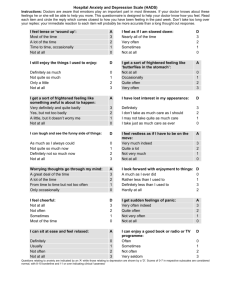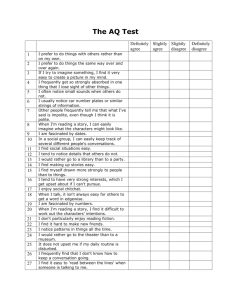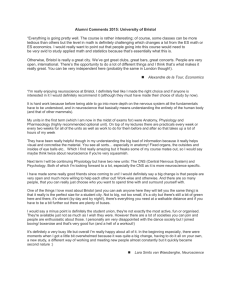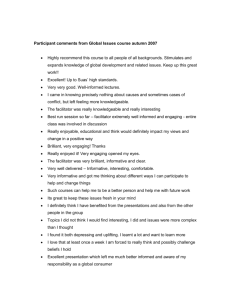Here
advertisement
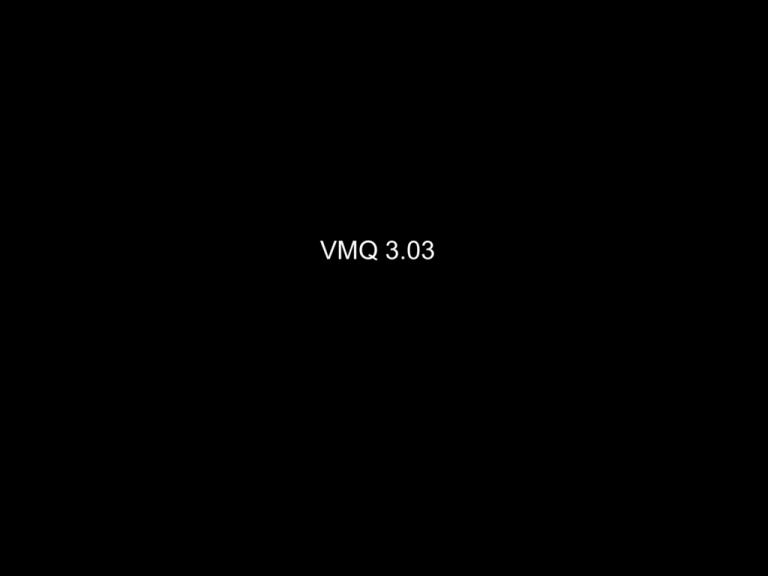
VMQ 3.03 Completing the Scantron • Fill in your name on the scantron (Last, First) and student # • Under “Test Code” bubble in “02” • Under “Special Code” Bubble in your subject number - the experimenter will be able to tell you this. Memory for Pictures • Imagine your memory for pictures is being tested. In the test you are first shown a number of pictures from magazines (ranging from natural scenes to individual objects). You can see each picture for three seconds. After you see the first set of pictures, you see a second set of pictures, half of which are from the first set and half of which are new. Your job is to indicate if a picture is old or new. • You will not actually do this task, but you will see some examples of the task. • Get ready, the next few slides will give some examples of pictures from the initial set. • Your job would be to remember these pictures… and so on..... • Get ready, the next few slides will start with the second set of pictures that you would be tested on. • You would have to decide for each picture whether it was in the initial set or not, by responding “OLD”(meaning the picture was in the initial set) or “NEW”(meaning the picture was not in the initial set) Is this picture “OLD” or “NEW”? Is this picture “OLD” or “NEW”? Is this picture “OLD” or “NEW”? and so on... Question 1 • How accurate do you think your responses would be if the initial set contained 20 pictures? a. very accurate b. accurate c. somewhat accurate d. barely accurate - 90-100% correct 80-89% correct 70-79% correct 60-69% correct e. inaccurate - guessing - 50-59% correct Question 2 • How accurate do you think your responses would be if the initial set contained 50 pictures? a. very accurate b. accurate c. somewhat accurate d. barely accurate - 90-100% correct 80-89% correct 70-79% correct 60-69% correct e. inaccurate - guessing - 50-59% correct Question 3 • How accurate do you think your responses would be if the initial set contained 1000 pictures? a. very accurate b. accurate c. somewhat accurate d. barely accurate - 90-100% correct 80-89% correct 70-79% correct 60-69% correct e. inaccurate - guessing - 50-59% correct Question 4 Have you ever heard about research on people’s memory for pictures before-- in an experiment, in class, on TV, or elsewhere? A = Yes B = No Changes in scenes Imagine that you are watching a movie. In a certain scene, two people are talking. While one of them is talking the camera cuts to another view. In the new shot, the actor who is talking is wearing a different shirt and the basketball she is holding has changed from blue and white to orange. You were not trying to detect changes. •Blue basketball jersey •Yellow basketball jersey •Blue and white basketball •Orange basketball Question 5 • Would you notice that the actor’s shirt and/or basketball changed if you were not trying to detect changes? a. b. c. d. I definitely would not have noticed the change I probably would not have noticed the change I probably would have noticed the change I definitely would have noticed the change Imagine that you are watching a movie. In a certain scene, an actor is sitting at his desk in a small office. The actor looks up in response to a ringing phone, gets up from his chair and walks by the camera to answer the phone in the hall. In the next shot a different actor, wearing different clothes, walks by the phone and answers it. You were not trying to detect changes. Actor 1 Actor 2 Question 6 • Would you notice that the actors in the first and second shots were different if you were not trying to detect changes? a. b. c. d. I definitely would not have noticed the change I probably would not have noticed the change I probably would have noticed the change I definitely would have noticed the change • Imagine that you are watching a movie. In a certain scene, two actors are having a conversation in a restaurant. In a series of shots you see one actor, then the other as each in turn talks. In one shot, there are red plates on the table. In the next shot, the plates are white instead of red. You were not trying to detect changes. Plates-- red Plates-- white Question 7 • Would you notice the plates change color if you were not trying to detect changes? a. b. c. d. I definitely would not have noticed the change I probably would not have noticed the change I probably would have noticed the change I definitely would have noticed the change Imagine that you are looking at a picture with ten different objects in it. While you are looking at the picture, it unexpectedly disappears for a moment, then reappears. When the picture reappears, one of the ten objects in it is different: a monkey has changed into a shirt. You were not trying to detect changes. monkey shirt Question 8 • Would you notice that the monkey had changed into the shirt if you were not trying to detect changes? a. b. c. d. I definitely would not have noticed the change I probably would not have noticed the change I probably would have noticed the change I definitely would have noticed the change Question 9 Have you ever heard about research on detecting changes before-- in an experiment, in class, on TV, or elsewhere? A = Yes B = No Imagine that you are in a psychology experiment where you are asked to detect changes in scenes. Each scene is presented for a brief time. Then the scene disappears for a moment, then reappears and something is different. Some of the scenes would be normal and some would be jumbled. Your job is to determine what has changed. So, you are actively searching for changes. Here is an example scene. The next few slides will demonstrate the change. Jumbled scene scene disappears and reappears The duck changed from yellow to green Question 10 : Do you think you would notice that the duck changed from yellow to green in this jumbled scene? a. I definitely would not have seen that the duck changed b. I probably would not have seen that the duck changed c. I probably would have seen that the duck changed d. I definitely would have seen that the duck changed Normal scene scene disappears and reappears The duck changed from yellow to green Question 11 : Do you think you would notice that the duck changed from yellow to green in this normal scene? a. I definitely would not have seen that the duck changed b. I probably would not have seen that the duck changed c. I probably would have seen that the duck changed d. I definitely would have seen that the duck changed Question 12 • Have you ever heard about research on detecting changed in normal and jumbled scenes-- in an experiment, in class, on TV, or elsewhere? A = Yes B = No Question 13 • Imagine that you are watching a movie and are not necessarily trying to remember it. What percentage of the scenes in the movie do you estimate you will remember after watching it once? a. 0-10% b. 11-20% c. 21-30% d. 31-40% e. 41-50% f. g. h. i. j. 51-60% 61-70% 71-80% 81-90% 91-100% Question 14 • Imagine that you are watching a movie and are trying to remember everything in it. What percentage of the scenes in the movie do you estimate you will remember after watching it once? a. 0-10% b. 11-20% c. 21-30% d. 31-40% e. 41-50% f. g. h. i. j. 51-60% 61-70% 71-80% 81-90% 91-100% Question 15 •Imagine that you witness a car accident. One month later you are in court and are asked if a particular person was also at the scene of the accident. If there were 10 people in the crowd watching the accident, how likely is it that you’d remember this particular person? a. I would definitely not remember this person b. I would probably not remember this person c. I would probably remember this person d. I would definitely remember this person Question 16 • Imagine you are at a museum looking at painting. While you are looking at the painting, would you see the frame it is in? a. I would definitely not see the frame b. I would probably not see the frame c. I would probably see the frame d. I would definitely see the frame Question 17 • Imagine you are looking at a friend standing in line for a movie across the street from you. While you are looking at your friend would you see a fire hydrant ten feet away from him/her? a. I would definitely not see the fire hydrant b. I would probably not see the fire hydrant c. I would probably see the fire hydrant d. I would definitely see the fire hydrant Question 18 • When you are looking at a complex real-world scene with many objects such as a cluttered desk top or a city street scene, what percent of the objects in the scene, on average, do you look at? a. 0-10% f. 51-60% b. 11-20% g. 61-70% c. 21-30% h. 71-80% d. 31-40% i. 81-90% e. 41-50% j. 91-100% • Imagine you are at a cocktail party and many different people are having many different conversations. You are in a group with your friends and there is another group near you. You are paying attention to what a person in your group is saying. The illustration below gives an example… Your group of friends The other group Question 19 • While you are paying attention to what someone in your group is saying, do you think that you would understand the meaning of the other group’s conversation? a. I would definitely not understand the meaning of the other conversation b. I would probably not understand the meaning of the other conversation c. I would probably understand the meaning of the other conversation d. I would definitely understand the meaning of the other conversation Question 20 • While you are paying attention to what someone in your group is saying, do you think you would notice if the people in the other conversation mentioned your name? a. I would definitely not hear my name b. I would probably not hear my name c. I would probably hear my name d. I would definitely hear my name Question 21 Have you ever heard about research on paying attention to one thing while ignoring other things-- in an experiment, in class, on TV, or elsewhere? A = Yes B = No • Imagine that you experience the following array of 12 letters briefly flashed before you for 50ms (1/20 of a second): T K W Q R L Y N C X E O Question 22 • Once the letters disappear, how many do you think you could correctly report to the experimenter? a. 0-1 b. 2-3 c. 4-5 d. 6-7 e. 8 or more Question 23 • During the moment immediately after the array disappears, can you briefly “see” the array, even though it isn’t physically present? a. I definitely would not be able to “see” the array b. I probably would not be able to “see” the array c. I probably would be able to “see” the array d. I definitely would be able to “see” the array Question 24 • During the moment immediately after the array disappears, do you think you can retain more visual information than you can report? a. b. c. d. I definitely would not be able to retain more than I could report I probably would not be able to retain more than I could report I probably would be able to retain more than I could report I definitely would be able to retain more than I could report Question 25 Have you ever heard about research on momentarily retaining information in briefly presented displays-- in an experiment, in class, on TV, or elsewhere? A = Yes B = No • Imagine you are given a task on a computer where you have to search for an upright green rectangle (like this: ) among a bunch of upright red rectangles (like this: ). Your job is to find that upright green rectangle and press a button on the computer when you find it. •Question 26: How fast do you think you would be at finding the green rectangle if there were 5 red rectangles in the display? target a. very fast Example b. somewhat fast c. somewhat slow d. very slow Question 27 How fast do you think your search would be if there were 300 red rectangles instead of 5 red rectangles? a. A lot faster b. somewhat faster target c. The same d. somewhat slower e. A lot slower Example • Imagine you are given a task on a computer where you have to search for an upright green rectangle (like this: ) among a bunch of other rectangles-- red sideways and upright and green sideways (like this: ). Your job is to find that upright green rectangle and press a button on the computer when you find it. •Question 28: How fast do you think you would be at finding the green rectangle with 5 of these other rectangles in the display? a. very fast Example b. somewhat fast c. somewhat slow d. very slow target Question 29 How fast do you think your search would be if there were 300 of these other rectangles instead of 5 other rectangles? a. A lot faster b. somewhat faster target Example c. The same d. somewhat slower e. A lot slower Question 30 Have you ever heard about research on searching for a target in a display before-- in an experiment, in class, on TV, or elsewhere? A = Yes B = No • I am going to ask you now about how we see. When people look at someone or something, do you think: that something like rays, energy or anything else goes into the eyes OR that something like rays, energy or anything else, comes out of their eyes OR that something like rays, energy or anything else goes into and comes out of their eyes at the same time Please wait to respond, the next slide will illustrate each of these choices… Question 31: Choose which best illustrates how we see. a. Rays coming IN are required for seeing b. Rays coming OUT are required for seeing c. Rays coming IN and OUT at the same time are required for seeing Question 32 Have you ever heard about research on whether people think something goes out of the eyes when we see-in an experiment, in class, on TV, or elsewhere? A = Yes B = No • Imagine you are watching a video of two teams, each passing basketballs back and forth. People in one team have white shirts on and people in the other team have black shirts on. • Your task is to continuously watch the white team and to count the number of times that they pass the ball, while ignoring the black teams passes. While you are counting passes, a man dressed in a gorilla suit walks through the teams, bangs his chest and walks out. Man in gorilla suit Question 33 • If you were counting passes, do you think you would notice the man in the gorilla suit walk through and bang his chest? a. b. c. d. I definitely would not notice the man in the gorilla suit I probably would not notice the man in the gorilla suit I probably would notice the man in the gorilla suit I definitely would notice the man in the gorilla suit • Imagine you are driving and you are trying to think of the answer for one question of a cross word puzzle you were working on this morning. You are rehearsing the question in your mind and trying to think of the answer. While you are driving and thinking there is a pedestrian crossing sign on your right. Question 34 • While you were rehearsing the crossword puzzle in your head, trying to think of the answer do you think you would notice the pedestrian sign on your right? a. b. c. d. I definitely would not notice the pedestrian sign I probably would not notice the pedestrian sign I probably would notice the pedestrian sign I definitely would notice the pedestrian sign • Now imagine you are driving and you are thinking about how you would rearrange your living room (where you will put the couch, TV etc.). You are creating a mental image in your mind of your living room. While you are driving and thinking there is a pedestrian crossing sign on your right. • Question 35: While you were picturing how to rearrange your living room do you think you would notice the pedestrian sign on your right? a. b. c. d. I definitely would not notice the pedestrian sign I probably would not notice the pedestrian sign I probably would notice the pedestrian sign I definitely would notice the pedestrian sign Question 36 Have you ever heard about research on dual task performance or the ability to do many things at once-in an experiment, in class, on TV, or elsewhere? A = Yes B = No • Imagine that you were an airplane pilot and you were asked to help test a flight simulator under various environmental conditions. Among many practice runs flying with the simulator there was a runway obstruction. A plane pulled out in front of you on the runway. Question 37: What percentage of pilots do you think would fail to notice the obstruction in their practice runs with the simulator? a. 0%-5% f. 26%-30% b. 6%-10% g. 31%-35% c. 11%-15% h. 36%-40% d. 16%-20% i. 41%-45% e. 21%-25% j. 46%-50% Question 38 Have you ever heard about research on pilots’ ability to detect obstructions in landing -- in an experiment, in class, on TV, or elsewhere? A = Yes B = No Features on a penny--think of how many you could remember without looking 1. “In God we Trust” 5. “ United States of America” 2. “Liberty” 6. “ONE CENT” 3. Lincoln head 7. “E-pluribus-unum” 4. Year “1996” 8. Lincoln memorial building 1 2 3 4 5 6 7 8 If you were asked to draw a penny from memory, do you think you would place the features correctly. Use the next few questions to answer. • Question 39: Do you think you would place Lincoln’s head facing the correct direction? a. b. c. d. I definitely would not I probably would not I probably would I definitely would Question 40 • Do you think you would remember to put “Liberty” on the coin? a. b. c. d. I definitely would not I probably would not I probably would I definitely would Question 41 • Do you think you would remember to put “United States of America” on the building side of the coin and at the top, above the building? a. I definitely would not b. I probably would not c. I probably would d. I definitely would Question 42 • Do you think you would remember to put the date on the head side of the coin and to the right of Lincoln’s head? a. I definitely would not b. I probably would not c. I probably would d. I definitely would Question 43 Have you ever heard about research on remembering features of familiar objects before-- in an experiment, in class, on TV, or elsewhere? A = Yes B = No Question 44 • Imagine that you were going to take a picture of a fish you just caught and you wanted to make the fish look bigger than it really was. How could you do this without moving anything but the fish? Use the diagram below to choose where you could hold the fish to make the fish look bigger. a. Hold the fish close to the camera b. Hold the fish just in front of you c. Hold the fish slightly behind you a. camera b. c. You Question 45 • If you are looking at the moon when it is close to the horizon it looks bigger compared to when it is high in the sky. Why does the moon look bigger when it is close to the horizon? a. It looks bigger because it is closer b. It looks bigger because it is farther away c. It looks bigger because it appears to be close to things that are far away d. It looks bigger because it is near the horizon Question 46 A B C • If you wanted to place this yellow block in this picture to make it look as big as possible, where would you place it? Question 47 Have you ever heard about research on perception of things that are far away before-- in an experiment, in class, on TV, or elsewhere? A = Yes B = No Question 48 In order to see visual changes such as those described earlier, is it necessary to focus your attention on the changing object, or would you see the change even if your attention were not focused on the changing object? a. It is absolutely necessary to focus attention on the changing object or you will not see it change b. It helps a lot to focus attention on the changing object to see it change c. It helps a little to focus attention on the changing object to see it change d. It doesn’t really matter if you focus attention on the changing object to see it change Question 49 In order to remember information, is it necessary to focus your attention on that information, or would you remember the information even if your attention were not focused on that information? a. It is absolutely necessary to focus attention on information you want to remember or you will not remember it b. It helps a lot to focus attention on information you want to remember c. It helps a little to focus attention on information you want to remember d. It doesn’t really matter if you focus attention on information you want to remember Question 50 When you answered questions about seeing visual changes (for example, the question about seeing the plates change from red to white) did you assume that the changes were unexpected and that you were not on the lookout for them, or did you assume that you were actively looking for some sort of change? a. I assumed the change was not expected, and that I was not on the look out for a change b. I assumed that I was actively looking for changes c. I assumed neither d. Don’t remember • Question 51: If you are male, fill in A If you are female, fill in B • Question 52: fill in first digit of your age • Question 53: fill in second of your age • Question 54: Do you have normal or corrected-to-normal vision? (color blindness would not be normal) A = Yes B = No • Question 55: Education--choose highest level obtained a. b. c. d. e. Doctoral degree Masters degree 4-year college degree 2-year college degree Some college f. Trade school g. High school degree h. Part high school i. 8th grade j. Less than 8th grade • Question 56: If you are in college what year are you a. b. c. d. • • Freshman Sophomore Junior Senior c. d. e. f. Junior Senior Post-graduate Other Question 57: If you are in college or have been in college how many psychology classes have you taken? Fill in the correct number--if it is more than 9 just fill in 9. Question 58: What was your combined SAT score, use an estimate? a. 1600 - 1300 b. 1299 - 1000 c. 999 - 700 d. Below 700 e. Not applicable/don’t know • Question 59: What was your combined ACT score, use an estimate? a. 36 - 30 b. 29 - 23 c. 22 - 16 d. Below 16 e. Not applicable/don’t know • Question 60: If applicable, what is your current GPA? a. b. c. d. e. 4.0 - 3.5 3.4 - 3.0 2.9 - 2.5 2.4 - 2.0 Below 2.0 • Question 61: If applicable, make a list of those psychology courses you have taken (write this in the blank for item 61 on the answer sheet) • Question 62: If you are in college what is your major (write this in the blank for item 62 on the answer sheet) • Question 63: If you are not in college, what is your occupation? (write this in the blank for item 63 on the answer sheet)


